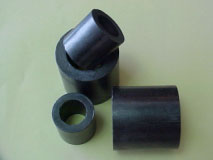|
| |
 Raschig rings made from Carbon or Graphite are used in specific applications demanding good corrosion and thermal shock resistance. They are resistant to most acids, alkalis and solvents at temperatures as high as 150 dec. C and also display good erosion and thermal shock resistance. At the same time they have high crushing strength, thus have a long life They are available in variable sizes such as (mm): 10,19,25,38,50 & 75 Raschig rings made from Carbon or Graphite are used in specific applications demanding good corrosion and thermal shock resistance. They are resistant to most acids, alkalis and solvents at temperatures as high as 150 dec. C and also display good erosion and thermal shock resistance. At the same time they have high crushing strength, thus have a long life They are available in variable sizes such as (mm): 10,19,25,38,50 & 75 |
R-ring is the equivalent of metal Raschig ring.
Since 1914 when F.Raschig invented this type of ring for tower packing, random tower pickings have been developed extensively. The T.C.I R-ring is now used in many applications, but particularly in supporting catalyst beds.
Metal T.C.I -R-rings are available in a wide range of carbon and stainless steels.and ceramic, PTFE, PP, etc. Ceramic Rashing ring |
 |
| Metal Raschig rings’ characteristics |
Size
(mm) |
Bulk density
(kg/m3) |
Number
per m3 |
Surface area
(m2/m3) |
Free volume
|
| 15×15×0.3 |
379 |
230000 |
350 |
95 |
| 25×25×0.4 |
318 |
51000 |
216 |
96 |
| 25×25×0.5 |
400 |
51000 |
220 |
95 |
| 35×35×0.8 |
430 |
19000 |
150 |
93 |
| 50×50×0.5 |
203 |
6500 |
106 |
97.4 |
| 50×50×0.7 |
285 |
6500 |
108 |
96.4 |
| 50×50×0.8 |
325 |
7000 |
109 |
95 |
| 76×76×0.8 |
212 |
1830 |
69 |
97.3 |
| 80×80×1.2 |
300 |
1600 |
65 |
96 |
| 90×90×1.0 |
236 |
1160 |
62 |
97 |
|
| All of the given weights refer to the stainless(AISI304)Raschig ring |
|
|
|
|

